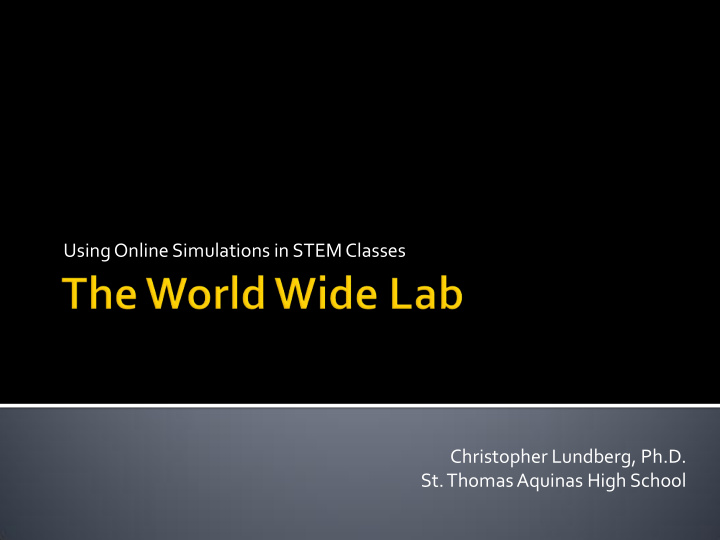



Using Online Simulations in STEM Classes Christopher Lundberg, Ph.D. St. Thomas Aquinas High School
Popular Science The Telegraph
National Math & Science Initiative, 2013 By 4 th grade, one-third of students lose interest in science. By 8 th grade, one-half of students lose interest. By 12 th grade, 60% of students who like STEM classes as freshmen have changed their minds. Data from Huneycutt, 2013
White House, 2012
PASSIVE LEARNING ACTIVE LEARNING
“ Hands-on laboratory science experiences are critical to the “Meaningful learning will occur learning process across all areas where laboratory activities are of study, beginning with a well-integrated part of a kindergarten and continuing learning sequence. ” through post-secondary American Association of education .” Physics Teachers, 1992 American Chemical Society, 2014 “For science to be taught properly and effectively, labs must be an integral part of the science curriculum .” National Science Teachers Association, 2006
Well-designed labs may provide: Reinforcement of science content and information Development of scientific reasoning Insight into the scientific process Increased interest in science Improved teamwork skills
Online simulations should not be considered equal alternatives to inquiry- driven labs. Instead, they could be an effective supplement to labs and lectures.
Online simulations can help students: Understand concepts across multiple 1. representations. Construct mental models of biological, chemical, 2. and physical systems. Participate in active learning at own pace. 3. Understand equations as physical relationships 4. among measurements. Collaborate to accomplish a goal. 5. Investigate phenomenon that would be impossible 6. or impractical to observe in a classroom or lab. Gende, 2011
Online simulations may be useful as: Complement to lecture Interactive demonstration Homework assignment Pre-lab assignment Make-up lab assignment
Neuron Lab Complement to lecture material https://phet.color ado.edu/en/simul Helps to visualize abstract concepts ation/neuron
Interactive demonstration Student prediction and observation pH Sim https://phet.colora do.edu/en/simulati on/ph-scale
Homework/classwork assignment In lieu of traditional problems Pepper Moth Sim https://askabiolo gist.asu.edu/sites /default/files/Pep perMoth/pepper- moths.swf
Pre-lab assignments Introduce new procedures Titration Sim http://www.mhh e.com/physsci/c hemistry/animat ions/chang_7e_ esp/crm3s5_5.s wf
Virtual labs When a traditional lab is not possible Beta Decay Lab https://phet.col orado.edu/en/si mulation/legacy /beta-decay
Simulation goals are clearly communicated. Perform a trial run of full procedure. Have students predict and explain their expected outcome. Avoid giving detailed, step-by-step instructions. Provide open-inquiry or guided-inquiry assignments. Have students reflect on and discuss the results of the simulation. Incorporate learning objectives into post- simulation discussion.
Hardware: desktop, laptop, tablet Internet connection Browser: Explorer, Safari, Chrome, Firefox Software: Flash, Java
ASU’s Ask a Biologist Sims https://askabiologist.asu.edu/games-and-simulations HHMI BioInteractive Virtual Labs http://www.hhmi.org/biointeractive/explore-virtual- labs McGraw’s Biology Virtual Labs http://highered.mheducation.com/sites/0073031208/s tudent_view0/virtual_labs.html Pearson’s Lab Bench http://www.phschool.com/science/biology_place/labb ench/index.html
ChemCollective http://chemcollective.org/activities/type_page/1 Concord Consortium’s Molecular Workbench http://mw.concord.org/modeler/ MERLOT List of Sims (w/ Peer Reviews) https://www.merlot.org/merlot/materials.htm PhET Chemistry Simulations https://phet.colorado.edu/
CK-12 Exploration Series http://www.ck12.org/student/ My Physics Lab http://www.myphysicslab.com/ PhET Physics Simulations https://phet.colorado.edu/ The Physics Classroom’s Interactives http://www.physicsclassroom.com/Physics- Interactives
Gende, D. (2011, April 1). Science Simulations: A Virtual Learning Environment. Retrieved from http://plpnetwork.com/2011/04/01/science-simulations-a-real- way-to-learn/ Huneycutt, T. (2013 December 13). Starting STEM Early: The Need for Vertical Alignment. Retrieved from http://www.nms.org/Blog/TabId/58/PostId/212/starting-stem-early-the-need-for- vertical-alignment.aspx Science Education Resource Center. (2016) Teaching with Simulations, Pedagogy in Action . Retrieved from http://serc.carleton.edu/sp/library/simulations/index.html Waldrop, M.M. (2015). Why we are teaching science wrong, and how to make it right. Nature, 523, 272-274. doi: 10.1038/523272a White House (2012). President's Council of Advisors on Science and Technology. Engage to excel: producing one million additional college graduates with degrees in science, technology, engineering, and mathematics .
Recommend
More recommend